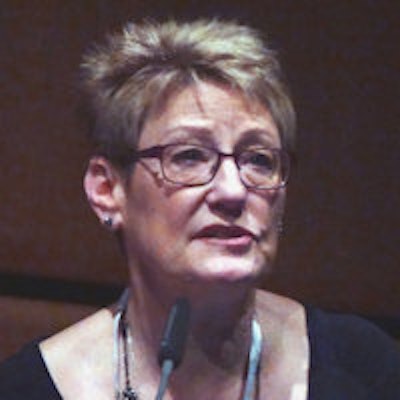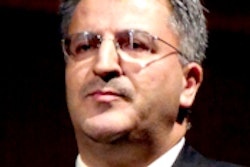
Myriad details remain to be ironed out, but the massive National Lung Screening Trial (NLST) has all the evidence it needs to recommend CT lung cancer screening for long-term smokers, according to a presentation by principal NLST investigator Dr. Denise Aberle at ECR 2014.
The remaining questions all revolve around how screening should be implemented, she told the delegates. Healthcare needs to improve its game in identifying who needs screening, sharpen its definitions of positivity based on nodule characteristics, and hone its diagnostic algorithms for following up CT scans.
But the evidence shows we're ready, according to Aberle, who is a professor of radiology and bioengineering at the University of California, Los Angeles (UCLA).
"I think that screening can be done on a large scale," she said. "We need to determine ways to reduce false-positivity rates, we must couple screening with smoking cessation, and we must collect the data" gleaned from CT scans.
Three years after NLST
Where are we now, almost three years after publication of the 2011 NLST results? The trial of some 53,000 asymptomatic long-term smokers showed a 20% reduction in lung cancer mortality with three annual screens using low-dose helical CT. But it came with an estimated 10% overdiagnosis rate, a positive predictive value around 4%, and therefore a relatively high cost per lung cancer detected, Aberle said.
 Dr. Denise Aberle from UCLA.
Dr. Denise Aberle from UCLA.
The U.S. Preventive Services Task Force (USPSTF) last year moved population-based screening a step closer to reality; the agency issued a draft recommendation (grade B) to provide annual CT screening to high-risk individuals ages 55 to 80 years with a smoking history of 30 pack-years or more, based on NLST and other data.
"This is good news -- this actually means that private insurers in the U.S. are obligated to pay for screening," Aberle said. "It does not obligate the federal government and our Medicare programs, and they are currently in deliberations."
USPSTF based its analysis not only on the results of U.S. and European trials, but also on the basis of modeling exercises performed by the U.S. National Cancer Institute's Cancer Intervention and Surveillance Modeling Network (CISNET), a consortium of five groups, each with its own evidence for the natural history of lung cancer, Aberle explained.
Combining the five models and varying the inputs in hundreds of screening scenarios, the CISNET analysis showed an average mortality reduction of about 14% and predicted that about half of lung cancers would be early-stage with CT screening. About 500 lung cancer deaths per 100,000 participants could be prevented -- with 575 screens needed to avert each death.
In the end, NLST recommended an upper age limit of 80 years for annual screening as its best estimate of optimal screening frequency, Aberle said of the study published online December 31, 2013, and in print in March (Annals of Internal Medicine, March 4, 2014, Vol. 160:5, pp. 311-320).
The five-year gap between NLST's 74-year-old upper age limit for screening and USPSTF's limit of 80 years represents the only difference between the two screening recommendations, she said. And data from the Surveillance, Epidemiology, and End Results (SEER) program seem to confirm that raising the upper age limit for screening to 80 years would catch more cancers -- from about 40% of all lung cancers accounted for among 55 to 74 year olds to about 60% of all lung cancers accounted for among 55 to 80 year olds.
But age is just one component of risk, and in NLST data, age didn't pack the predictive punch of other factors such as pack-years, body mass index, years since quitting, having emphysema, and family history of lung cancer, according to a hazards model analysis of the different risk factors published last year by Kovalchik et al in the New England Journal of Medicine.
The hunt for higher-risk participants
Kovalchik's team applied its risk model to NLST and validated the results against those of the Prostate, Lung, Colorectal, and Ovarian (PLCO) Cancer Screening Trial, shunting the population into five risk quintiles. As risk levels increased, so did the numbers of lung cancers, early-stage lung cancers, and deaths. The false-positive rate dropped substantially in the higher-risk cohorts, along with the numbers needed to screen, Aberle noted.
The bottom line is that the three highest-risk quintiles account for nearly 90% of all lung cancers and nearly two-thirds of the positive screens, she said, while the lowest risk accounted for just about 1% of screen-prevented deaths.
This is great data because Kovalchik and colleagues "have shown nicely that we can increase the risk profile of the screening population with little to no deleterious effect, and improve substantially on the original NLST criteria," Aberle said. Some U.S. screening centers are tweaking the screening criteria to do just that.
Boosting nodule size to define a screen as positive is another way to improve the risk-benefit ratio, Aberle said. In NLST, nodules 7 mm and larger in diameter showed approximately a two- to threefold increase in the number of lung cancers over smaller nodules, with, for example, about 21% positive screens versus 6.9% for nodules 4- to 6-mm in size.
But that doesn't tell the whole story. Nodules 10 mm and larger that were solid, part-solid, or ground glass had a relatively high rate of diagnosis. Nodules in the 7-mm range tended to develop lung cancers slightly later in time and at lower rates, she said.
As for the small 4- to 6-mm nodules, solid nodules followed by part-solid nodules followed by ground-glass nodules were the likeliest to progress to cancer, but the rate was relatively low, "and we can easily increase our nodule size without significant delay in the diagnosis of lung cancer," Aberle said.
Time is a crucial element in some scenarios. Ground-glass nodules showed a stable rate of diagnosis and growth, finally exceeding the diagnosis rate of solid nodules six years after screening began. "I think this has implications for how long we need to be following people with ground-glass nodules," she said.
People with combinations of nodule types had the highest lung cancer diagnosis rates -- more than 16% at year 7. But people with no nodules at baseline screening had less than a 3% rate of lung cancer diagnosis seven years after screening began.
"I think this gives us important information about what we can do in the context of a truly negative screen," she said. "I think in that setting, we should be able to increase the interval between screens" to 18 months or two years, as is currently being debated.
"The point is, we can reduce costs, reduce false-positive rates, and reduce the numbers of people who are being screened if we don't screen negative individuals annually," she said.
Several organizations are looking to redefine a positive screen, most honing in on 6- to 7-mm in diameter as the "sweet spot," Aberle said, as they seek to redefine screening intervals, via either a randomization process for a "pragmatic trial," or potentially in a full clinical trial setting.
Interval blues
Interval cancers that occur between screens after a negative finding are rare (in NLST, n = 44, 0.08%) but they do happen, and they can be deadly, according to Aberle. In one NLST case, a woman with multiple ground-glass nodules at baseline screening missed her recommended three-month follow-up, but came back at 7.5 months to present with advanced-stage disease.
"How do we screen this woman? We don't," Aberle said. People with biologically very aggressive cancers "are not going to be sensitive to imaging-based screening at this time."
"We don't know enough about the molecular biology of these tumors, and I'm hoping that as we get more educated about the biology, we will complement CT screening and, in fact, eventually replace CT screening with molecular markers of cancer risk in individuals," she said.
Classifying findings
The American College of Radiology (ACR) is busy creating a "LUNG-RADS" system to classify CT findings, patterned after BI-RADS for breast cancer screening, Aberle said. The following table offers a glimpse into the process; however, it remains very much a work-in-progress, as final decisions haven't been made, including how big a nodule needs to be before it can be considered positive for cancer.
| ACR's preliminary LUNG-RADS classification scheme | |
| Category | Management |
| 0 - Incomplete | Repeat or await historical images |
| 1 - Negative | Annual screening |
| 2 - Benign | Annual screening |
| 3 - Likely benign | Follow-up low-dose CT at 6 months |
| 4 - Suspicious | Follow-up LDCT at 4 months |
| 5 - Highly suspicious | Diagnostic imaging/tissue sampling |
| 6 - Significant/other | As appropriate to findings |
Preliminary or not, Aberle had reservations about the adequacy of the ACR classifications, saying, "these aren't exactly the words I would choose; this isn't exactly the system I would choose, but I was outvoted."
Cost-effectiveness
One of the most important analyses of the NLST data has also been one of its longest-delayed. Eagerly awaited in screening circles is the crucial cost-effectiveness study based on NLST. The study is complete, but finalizing the data for publication has been slow going.
Researchers modeled a chest radiography arm, the CT arm, and a no-screening arm that was not part of NLST. The authors calculated costs in U.S. dollars and measured effectiveness in quality-adjusted life years (QALY). Survival was modeled based on age, smoking, and diagnosis, and cost-effectiveness was calculated using direct costs of screening, follow-up, and treatment, as well as nonscreening-related costs such as travel and lost wages, Aberle said.
They developed utilization data from the American College of Radiology Imaging Network (ACRIN) portion of the trial, and they based discounted costs on Medicare pricing, including a 2002 chest CT cost of about $300. Finally, they plugged in NSLT's 10% overdiagnosis figure, and assumed that screening improved only lung cancer mortality figures.
In unpublished preliminary figures from the study, presented by lead author Dr. William Black to the National Cancer Institute board of scientific advisors in 2013, the researchers pegged the costs of low-dose CT at $2,770, put quality-adjusted life year gains at 11.01 years, and estimated dollars per QALY at $72,916, Aberle reported. The $72,000 cost per QALY came in quite a bit higher than the generally accepted $50,000 per QALY level for tests, but it falls within the range of other approved imaging tests such as breast cancer screening.
"What drives those costs are a number of things over which we have the capacity to improve that cost-effectiveness ratio," she said. Various subset analyses and sensitivity analyses performed on the data varied a number of factors such as overdiagnosis and costs.
Reducing the false-positive rate would result in less overdiagnosis, and screening higher-risk individuals would also lower costs, she said. Finally, if screening were used to promote smoking cessation, it would substantially increase the effectiveness of lung cancer screening. The data also suggest that screening is much more cost-effective in women than men, in higher versus lower risk groups, and in current versus prior smokers.
"Not surprisingly, a big driver of cost is the cost of the screening exam itself, because all of the people in the at-risk population receive that, even though only a small percentage develop lung cancer," Aberle said. "To the degree that we can reduce that, we can substantially lower the cost per quality-adjusted life year."
Transdisciplinary medicine
At UCLA, radiology is working in full partnership with pulmonary medicine, family practice, and thoracic surgery to "create a transdisciplinary system that cuts across the silos to look at lung cancer across its trajectory," Aberle said. "We want to co-locate so that we are all in the same area. We believe that in doing so we can more efficiently coordinate screening and patients who require additional workup."
Within this environment, the physicians also aim to standardize risk assessment via questionnaires, standardize management algorithms and interpretation protocols, and emphasize smoking cessation programs, Aberle said.




















